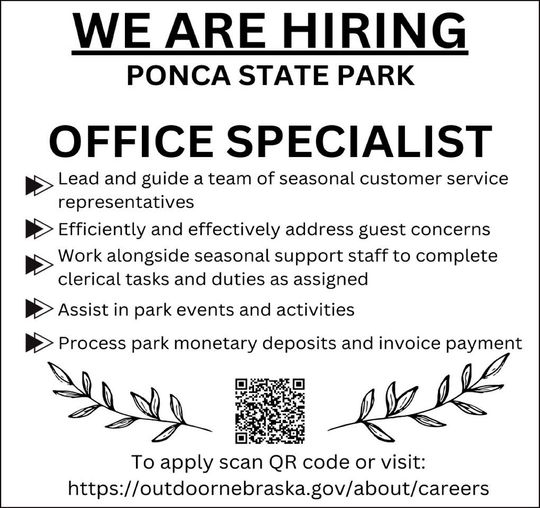(By Jeff Yost, President and CEO of Nebraska Community Foundation) As we enter fall, my thoughts are in spring. Particularly, my mind drifts back to those few weeks when our state becomes the temporary residence of nearly one million sandhill cranes.
The annual migration and the sandhill crane are a point of pride for Nebraskans. We find the bird's image on license plates, murals, business logos and the walls of art galleries across the state. Friends of mine in Red Cloud, for instance, recently treated Nebraska Community Foundation board members and staff to a tour of their glassblowing studio.
Among their work were stunning sculptures of the cranes that capture our imagination every year.
I find it powerful that what brings the cranes here is abundance. Nebraska has more acres of wetlands than any of our neighboring states, according to our friends at the Nebraska Game and Parks Commission. That means an abundance of food, shelter, and space where they can stretch their wings and feel safe enough to show off their dance moves (likely due to Nebraska being the only state in their path that outlaws hunting cranes).
Cranes and I agree on at least one thing: wetlands are amazing!
Wetlands simultaneously nurture, protect, cleanse and revitalize. They support plants and wildlife, use up surplus nutrients, are wildly diverse and purify our environment. Mutual benefit is the rule, as every species works interdependently with every other species to create a thriving ecosystem. For me, this habitat is supremely impressive and something we should all try to replicate with our friends and neighbors in our community building work.
For all my career (35 years and counting) I have been engaged in community economic development and public policy. Since 1998 I've proudly worked for Nebraska Community Foundation. Over those many years I've made many observations and drawn some conclusions regarding why some Nebraska hometowns thrive and others struggle.
The communities I see doing well have much in common with wetlands. They constantly nurture a community environment of optimism, collaboration, support for creative thinking, intentionality, mutual benefit, and occasionally challenging the status quo. Community members consistently show up – just like the cranes. They are trusting, grace- filled and happy. These communities
over-communicate. They correctly assume it's better if you're told something twice instead or not at all. These communities are building an ecosystem where individuals, organizations and ideas can germinate, grow, bloom and reproduce. Among the many vibrant communities in the NCF network, three such “wetlands” come to mind.
Over the past three decades nearly every home in Stuart (pop. 574) has been rehabilitated or newly built.
The local and regional economy is strong with numerous locally owned financial services, manufacturing and value-added agriculture enterprises.
Ten years ago, a 67-seat 3-D movie theater was created by rehabilitating an unused downtown building. About 8,000 people attend the movies every year in this volunteer-run facility.
And earlier this year Stuart opened Brain Builders, a state-of-the-art early childhood development center which will be an incredible asset for the region, not just the community. Young families are consistently moving to or staying in Stuart. School enrollment is growing. Nearly all students graduate every year and almost all pursue higher education.
There is a culture of transparency and over-communication in Stuart.
Community members show up for meetings well prepared and frequently already understand the issue or opportunity at hand and what their friends and neighbors think.
These practices pay dividends in the quality-of-life and sense of belonging in Stuart.
For 25 years community leaders in Ord and Valley County (pop.
4,158) have been leaning into their abundance and asking each other what more could happen. The list of accomplishments is long and growing. Local leadership capacity has grown dramatically, as more than 300 residents of Valley County and the region have participated in SynoVation Valley Leadership Academy since 2013. Valley County Economic Development has a full-time staff of three, including a full-time business coach focused on entrepreneurship. Valley County has been celebrated by the Kauffman Foundation as a rural entrepreneurial ecosystem to study and emulate.
Today, Ord benefits from a thriving downtown full of retail outlets, dining venues and Scratchtown, a homegrown brewpub.
In 2015, Valley County welcomed The Golden Husk as a community theater and meeting venue, which now hosts numerous local and traveling musical artists annually. In 2024 Valley County Health System was named a Top 100 Critical Access Hospital by Chartis Center for Rural Health. And the most important building block is a change of mindset summed up in this quote: “When you have trust, vulnerability follows,” said Melani Flynn, chair of the Valley County Community Foundation Fund. “People come to the table with new, innovative ideas and solutions.”
In south central Nebraska, Shickley (pop. 343) has always had a can-do attitude. Over and over again I see this community mobilizing its assets to work on what's next. "Please join us” is a mantra in Shickley, where a culture of invitation reigns supreme.
When I first got to know Shickley in 2002 one of the first things they shared with me is “We want to save our school!” And they have done just that. They achieved that goal by inviting every community member to give their time, talents and treasure to create mutual benefit. This has created a deep sense of belonging in Shickley – we belong through having our gifts and talents received and appreciated. This culture of invitation and belonging is paying all sorts of dividends. Shickley now has an early childhood development center as part of its school district. New homes are being built. Young families are moving in. And this can-do attitude is impacting the next generation. Shickley's 2025 Hometown Interns Hannah Miller and Mariah Silva put it this way: “We have watched these role models pave a path for the youth, and now it's our turn to do the same." Nebraska's hometowns are similar to wetlands – no two are the same but all have unappreciated abundance.
They attract life and goodness and support an evolving community.
What assets does your community already possess? Which could be easily adapted? Start with what you have and use that goodness to nurture a wetland that you proudly call home.







